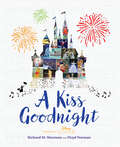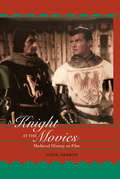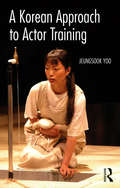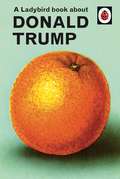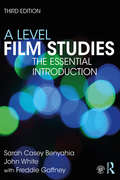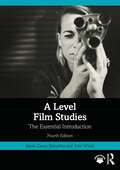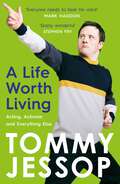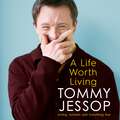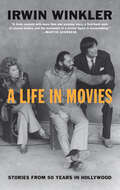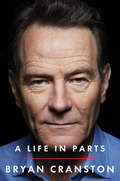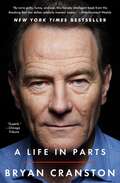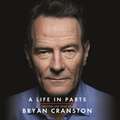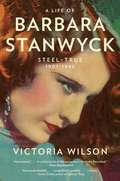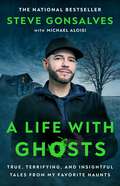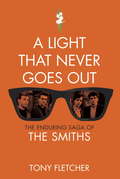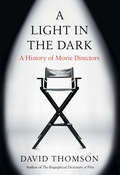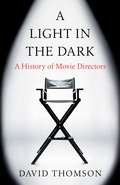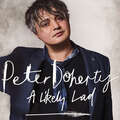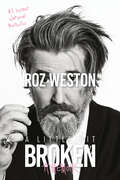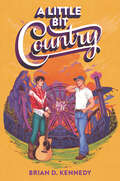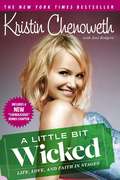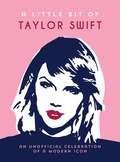- Table View
- List View
A Kiss Goodnight (Disney Editions Deluxe)
by Richard M. ShermanA beautifully illustrated storybook showcasing the lyrics to A Kiss Goodnight, written by Richard Sherman and heard every night at Walt Disney World and Disneyland during the fireworks shows.
A Knight at the Movies: Medieval History on Film
by John AberthImagining the Middle Ages is an unprecedented examination of the historical content of films depicting the medieval period from the 11th to the 15th centuries. Historians increasingly feel the need to weigh in on popular depictions of the past, since so much of the public's knowledge of history comes from popular mediums. Aberth dissects how each film interpreted the period, offering estimations of the historical accuracy of the works and demonstrating how they project their own contemporary era's obsessions and fears onto the past.
A Korean Approach to Actor Training
by Jeungsook YooA Korean Approach to Actor Training develops a vital, intercultural method of performer training, introducing Korean and more broadly East Asian discourses into contemporary training and acting practice. This volume examines the psychophysical nature of a performer’s creative process, applying Dahnhak, a form of Korean meditation, and its central principle of ki-energy, to the processes and dramaturgies of acting. A practitioner as well as a scholar, Jeungsook Yoo draws upon her own experiences of training and performing, addressing productions including Bald Soprano (2004), Water Station (2004) and Playing ‘The Maids’ (2013–2015). A significant contribution to contemporary acting theory, A Korean Approach to Actor Training provides a fresh outlook on performer training which will be invaluable to scholars and practitioners alike.
A Ladybird Book About Donald Trump (Ladybirds for Grown-Ups)
by Joel Morris Jason HazeleyAs we prepare to wave the President out of the White House, commemorate the past four years with this charming introduction to his very important life and his many, many friends - the perfect stocking filler this Christmas._________'When Donald won the election, he did not believe it."This election was a bad, unfair election," said Donald, about the election that he won.One day, Donald might lose an election. He will not like that election at all.And when Donald is told it is time to stop being the President, who knows what exciting things will happen next?'_________'Anyone can grow up to become the President.Or they can become President first and think about growing up later.'_________This delightful book is the latest in the series of Ladybird books which have been specially planned to help grown-ups with the world about them.Something the President himself could do with.The large clear script, the careful choice of words, the frequent repetition and the thoughtful matching of text with pictures all enable grown-ups to think they have taught themselves to cope.Featuring original Ladybird artwork alongside brilliantly funny, brand new text.Praise for The Story of Brexit:'Hilarious' Stylist'One of the Best Comedy Books of 2018' The List'The latest offering in the hilarious Ladybird for Grown Ups series is a funny mickey-take of the Brexit debate (and boy, do we need some fun)' Sunday Post
A Level Film Studies: The Essential Introduction (Essentials)
by John White Freddie Gaffney Sarah Casey BenyahiaThis essential book covers the key areas for A Level Film Studies students, building confidence through a careful, step-by-step approach. The first part of the book establishes a basic understanding of the grounding of film analysis in the various elements of film construction, mise en scène, cinematography, editing, sound and performance, developing the knowledge students have of movies whilst challenging them to consider new films and ideas. Key theoretical approaches around narrative, genre, representation, spectatorship and authorship are introduced in part two, before we consider specific national cinemas from around the world in parts three and four. In part five, the book assesses a range of slightly different film experiences, looking at silent cinema, experimental films and documentaries; before, finally, part six shifts to evaluating creative approaches to students’ own filmmaking. Specifically designed to be user-friendly, the book has an easy-to-follow design, includes more than sixty colour images and is packed with features such as: 1. case studies on a range of films and filmmakers, 2. activities on such films as Sunrise (Murnau, 1927, US), Vertigo (Hitchcock, 1958, US), Do the Right Thing (Lee, 1989, US), We Need to Talk About Kevin (Ramsay, 2011, UK), Stories We Tell (Polley, 2012, Can), 3. definitions of key terms, 4. suggestions for further reading and website resources. Matched to the current exam specification, A Level Film Studies: The Essential Introduction covers everything students need to study as part of the course. The book is supported by a companion website at www.alevelfilmstudies.co.uk offering further advice and activities.
A Level Film Studies: The Essential Introduction (Essentials)
by John White Sarah Casey BenyahiaBuilding confidence through a careful, step-by-step approach, this book is an essential companion for students undertaking A Level Film Studies.This book begins by establishing a basic understanding of film analysis, introducing film construction, mise en scène, cinematography, editing, sound, and performance. Key theoretical approaches to narrative, genre, representation, spectatorship, and authorship are then introduced, along with specific national cinemas from around the world. Next, students consider the unique experiences of silent cinema, experimental films, and documentaries. Finally, the focus shifts to evaluating creative approaches to students’ own filmmaking.Thoroughly revised and updated to match exam specifications for both Eduqas and OCR, the fourth edition of this essential textbook features: Case studies and activities relating to a number of films, including those new to the syllabus such as Get Out, Cléo from 5 to 7, and Belfast, each clearly signposted to the relevant board and specification Fully integrated online resources, cross-referenced within the text, to help students and instructors dive deeper into case studies and exam prep Even more chapter summaries and breakout boxes containing definitions of key terms, theories, and theorists throughout. Designed to be comprehensive and easy-to-use, A Level Film Studies: The Essential Introduction covers everything students need to succeed in their exams as well as inspiring further study.This book is supported by e-resources for students and instructors, including additional case studies, revision checklists, and key approaches to assessment.
A Life Worth Living: Acting, Activism and Everything Else
by Tommy Jessop'I can't recommend it highly enough' STEPHEN FRY | 'Everyone needs to hear his voice' MARK HADDONI'm a man on a mission to show that life with Down syndrome can be exciting and is worth living, so that other people understand and give us the chance to live life to the full and to be fulfilled. Tommy Jessop is a multi-award winning actor, theatre performer, and campaigner. Tommy has been at the vanguard of bringing awareness of the potential of people living with Down syndrome to the media, and to government. A Life Worth Living will be Tommy's story - from his journey into acting and campaigning while showing his unstoppable determination, charisma, and love for life. Tommy's natural instinct to help others leaps out from the pages, as does his wish to make people aware that those with learning disabilities just want to be treated like everybody else.
A Life Worth Living: Acting, Activism and Everything Else
by Tommy Jessop'I can't recommend it highly enough' STEPHEN FRY | 'Everyone needs to hear his voice' MARK HADDONI'm a man on a mission to show that life with Down syndrome can be exciting and is worth living, so that other people understand and give us the chance to live life to the full and to be fulfilled. Tommy Jessop is a multi-award winning actor, theatre performer, and campaigner. Tommy has been at the vanguard of bringing awareness of the potential of people living with Down syndrome to the media, and to government. A Life Worth Living will be Tommy's story - from his journey into acting and campaigning while showing his unstoppable determination, charisma, and love for life. Tommy's natural instinct to help others leaps out from the pages, as does his wish to make people aware that those with learning disabilities just want to be treated like everybody else.
A Life Worth Living: Acting, Activism and Everything Else
by Tommy JessopA powerful, moving and joyous memoir from Tommy Jessop, award-winning actor and activist.I'm a man on a mission to show that life with Down Syndrome can be exciting and is worth living, so that other people understand and give us the chance to live life to the full and to be fulfilled. Tommy Jessop is a multi-award winning actor, theatre performer, and campaigner. Tommy has been at the vanguard of bringing awareness of the potential of people living with Down syndrome to the media, and to government. A Life Worth Living will be Tommy's story - from his journey into acting and campaigning while showing his unstoppable determination, charisma, and love for life. Tommy's natural instinct to help others leaps out from the pages, as does his wish to make people aware that those with learning disabilities just want to be treated like everybody else. A Life Worth Living is a powerful, moving and joyous memoir, a must-listen. (P) Headline Publishing Group Ltd 2023
A Life in Movies: Stories from 50 years in Hollywood
by Irwin Winkler“A lively memoir . . . a first-hand work of cinema history . . . the testament of a pivotal figure in American moviemaking.” —Martin ScorseseThe list of films Irwin Winkler has produced in his more-than-fifty-year career is extraordinary: Rocky, Goodfellas, Raging Bull, De-Lovely, The Right Stuff, Creed, and The Irishman. His films have been nominated for fifty-two Academy Awards, including five movies for Best Picture, and have won twelve.In A Life in Movies, his charming and insightful memoir, Winkler tells the stories of his career through his many films as a producer and then as a writer and director, charting the changes in Hollywood over the past decades. Winkler started in the famous William Morris mailroom and made his first film—starring Elvis—in the last days of the old studio system. Beginning in the late 1960s, and then for decades to come, he produced a string of provocative and influential films, making him one of the most critically lauded, prolific, and commercially successful producers of his era.This is an engrossing and candid book, a beguiling exploration of what it means to be a producer, including purchasing rights, developing scripts, casting actors, managing directors, editing film, and winning awards. Filled with tales of legendary and beloved films, as well as some not-so-legendary and forgotten ones, A Life in Movies takes readers behind the scenes and into the history of Hollywood.“Charming and anecdote packed . . . popcorn for movie nerds.” —Newsweek“A deftly written recollection of an eventful and happy life in a precarious and, frankly, insane business; a remarkably clear-eyed look behind the scenes of moviemaking.” —Kevin Kline
A Life in Parts
by Bryan Cranston'Bryan Cranston has created a cinematic record of how an actor shapes a career and an identity and a legacy all at the same time' Tom Hanks'A superb anecdotalist with an honest take on how he dealt with fame found later in life' SUNDAY TIMES CULTUREWith BREAKING BAD, Bryan Cranston created moments that had the world on the edge of their seats and coined catchphrases that became famous all over the globe. Now, at last, we can learn of the man behind one of TV's most successful programmes ever. Bryan Cranston's profile has skyrocketed, due to his portrayal of chemistry teacher turned drug manufacturer Walter White, for five seasons in the award-winning BREAKING BAD.For the first time readers can discover how he beat off competition from Matthew Broderick and Steve Zahn for the role, to stories about the cast and life after Walter. Told with honesty and intrigue this will be Bryan's first - and - definitive autobiography. It is the ultimate book for the fans of BREAKING BAD.
A Life in Parts
by Bryan Cranston<P>A poignant, intimate, funny, inspiring memoir--both a coming-of-age story and a meditation on creativity, devotion, and craft--from Bryan Cranston, beloved and acclaimed star of one of history's most successful TV shows, Breaking Bad.Bryan Cranston landed his first role at seven, when his father cast him in a United Way commercial. Acting was clearly the boy's destiny, until one day his father disappeared. Destiny suddenly took a backseat to survival. <P>Now, in his riveting memoir, Cranston maps his zigzag journey from abandoned son to beloved star by recalling the many odd parts he's played in real life--paperboy, farmhand, security guard, dating consultant, murder suspect, dock loader, lover, husband, father. Cranston also chronicles his evolution on camera, from soap opera player trying to master the rules of show business to legendary character actor turning in classic performances as Seinfeld dentist Tim Whatley, "a sadist with newer magazines," and Malcolm in the Middle dad Hal Wilkerson, a lovable bumbler in tighty-whities. He also gives an inspiring account of how he prepared, physically and mentally, for the challenging role of President Lyndon Johnson, a tour de force that won him a Tony to go along with his four Emmys. <P>Of course, Cranston dives deep into the grittiest details of his greatest role, explaining how he searched inward for the personal darkness that would help him create one of the most memorable performances ever captured on screen: Walter White, chemistry teacher turned drug kingpin. Discussing his life as few men do, describing his art as few actors can, Cranston has much to say about creativity, devotion, and craft, as well as innate talent and its challenges and benefits and proper maintenance. But ultimately A Life in Parts is a story about the joy, the necessity, and the transformative power of simple hard work. <P><b>A New York Times Bestseller</b>
A Life in Parts
by Bryan Cranston'Bryan Cranston has created a cinematic record of how an actor shapes a career and an identity and a legacy all at the same time' Tom Hanks'A superb anecdotalist with an honest take on how he dealt with fame found later in life' SUNDAY TIMES CULTUREA poignant, intimate, funny, inspiring memoir - both a coming-of-age story and a meditation on creativity, devotion, and craft - from Bryan Cranston, beloved and acclaimed star of one of history's most successful TV shows, Breaking Bad.Bryan Cranston landed his first role at seven, when his father cast him in a United Way commercial. Acting was clearly the boy's destiny, until one day his father disappeared. Destiny suddenly took a backseat to survival.Now, in his riveting memoir, Cranston maps his zigzag journey from abandoned son to beloved star by recalling the many odd parts he's played in real life - paperboy, farmhand, security guard, dating consultant, murder suspect, dock loader, lover, husband, father. Cranston also chronicles his evolution on camera, from soap opera player trying to master the rules of show business to legendary character actor turning in classic performances as Seinfeld dentist Tim Whatley, "a sadist with newer magazines," and Malcolm in the Middle dad Hal Wilkerson, a lovable bumbler in tighty-whities. He also gives an inspiring account of how he prepared, physically and mentally, for the challenging role of President Lyndon Johnson, a tour de force that won him a Tony to go along with his four Emmys.Of course, Cranston dives deep into the grittiest details of his greatest role, explaining how he searched inward for the personal darkness that would help him create one of the most memorable performances ever captured on screen: Walter White, chemistry teacher turned drug kingpin.Discussing his life as few men do, describing his art as few actors can, Cranston has much to say about creativity, devotion, and craft, as well as innate talent and its challenges and benefits and proper maintenance. But ultimately A Life in Parts is a story about the joy, the necessity, and the transformative power of simple hard work.(p) 2016 Simon & Schuster
A Life of Barbara Stanwyck
by Victoria WilsonFifteen years in the making, the first volume of the full-scale astonishing life of one of our greatest screen actresses whose career in pictures spanned four decades beginning with the coming of sound--the first to delve deeply into Stanwyck's rich, complex life and to explore her extraordinary range of eighty-eight motion pictures, many of them iconic; her work, her world, her Hollywood through an American century.Frank Capra called her, "The greatest emotional actress the screen has yet known." Yet she was one of its most natural, timeless, and underrated stars. Now Victoria Wilson, gives us the most complete portrait we have yet had, or will have, of this magnificent actresses, seen as the quintessential Brooklyn girl whose family was in fact of old New England stock...her years in New York as dancer and Broadway star...her fraught marriage to Frank Fay, Broadway genius, who influenced a generation of actors and comedians (among them, Jack Benny and Stanwyck herself)...the adoption of a son, embattled from the outset; her partnership with the "unfunny" Marx brother, Zeppo, together creating one of the finest horse breeding farms in the west; her fairytale romance and marriage to the younger Robert Taylor, America's most sought-after male star...Here is the shaping of her career working with many of Hollywood's most important directors: among them, Capra, King Vidor, Cecil B. Demille, Preston Sturges, all set against the times--the Depression, the rise of the unions, the coming of World War II and a fast-evolving coming-of-age motion picture industry. At the heart of the book, Stanwyck herself--her strengths, her fears, her desires--how she made use of the darkness in her soul, keeping it at bay in her private life, transforming herself from shunned outsider into one of Hollywood's--and America's--most revered screen actresses. Written with full access to Stanwyck's family, friends, colleagues, and never-before-seen letters, journals and photographs.
A Life of Barbara Stanwyck
by Victoria WilsonFrank Capra called her "The greatest emotional actress the screen has yet known." She was one of its most natural, timeless, and underrated stars. Now, Victoria Wilson gives us the first full-scale life of Barbara Stanwyck, whose astonishing career in movies (eighty-eight in all) spanned four decades beginning with the coming of sound, and lasted in television from its infancy in the 1950s through the 1980s--a book that delves deeply into her rich, complex life and explores her extraordinary range of motion pictures, many of them iconic. Here is her work, her world, her Hollywood. We see the quintessential Brooklyn girl whose family was in fact of old New England stock . . . her years in New York as a dancer and Broadway star . . . her fraught marriage to Frank Fay, Broadway genius, who influenced a generation of actors and comedians (among them, Jack Benny and Stanwyck herself ) . . . the adoption of a son, embattled from the outset; her partnership with the "unfunny" Marx brother, Zeppo, crucial in shaping the direction of her work, and who, together with his wife, formed a trio that created one of the finest horse-breeding farms in the west; her fairy-tale romance and marriage to the younger Robert Taylor, America's most sought-after-- and beautiful--male star. Here is the shaping of her career with many of Hollywood's most important directors: among them, Frank Capra, "Wild Bill" William Wellman ("When you get beauty and brains together," he said, "there's no stopping the lucky girl who possesses them. The best example I can think of is Barbara"), King Vidor, Cecil B. De Mille, and Preston Sturges, all set against the times--the Depression, the New Deal, the rise of the unions, the advent of World War II--and a fast-changing, coming-of-age motion picture industry. And here is Stanwyck's evolution as an actress in the pictures she made from 1929 through the summer of 1940, where Volume One ends--from her first starring movie, The Locked Door ("An all-time low," she said. "By then I was certain that Hollywood and I had nothing in common"); and Ladies of Leisure, the first of her six-picture collaboration with Frank Capra ("He sensed things that you were trying to keep hidden from people. He knew. He just knew"), to the scorching Baby Face, and the height of her screen perfection, beginning with Stella Dallas ("I was scared to death all the time we were making the picture"), from Clifford Odets's Golden Boy and the epic Union Pacific to the first of her collaborations with Preston Sturges, who wrote Remember the Night, in which she starred. And at the heart of the book, Stanwyck herself--her strengths, her fears, her frailties, her losses and desires; how she made use of the darkness in her soul in her work and kept it at bay in her private life, and finally, her transformation from shunned outsider to one of Hollywood's--and America's--most revered screen actresses. Writing with the full cooperation of Stanwyck's family and friends, and drawing on more than two hundred interviews with actors, directors, cameramen, screenwriters, costume designers, et al., as well as making use of letters, journals, and private papers, Victoria Wilson has brought this complex artist brilliantly alive. Her book is a revelation of the actor's life and work.
A Life with Ghosts: True, Terrifying, and Insightful Tales from My Favorite Haunts
by Steve GonsalvesThe debut book from paranormal investigator and Ghost Hunters TV star Steve Gonsalves! Steve Gonsalves—already considered to be one of the top paranormal investigators in the world and a pioneer in the industry—now presents his debut book, A Life with Ghosts! Widely known as a lead investigator of the smash hit TV series Ghost Hunters as well as Ghost Hunters Academy and Travel Channel&’s ratings king, Ghost Nation, Steve presents a collection of his most meaningful paranormal experiences from some of his favorite haunted locations. Along with the compelling history of each location, Steve recounts his terrifying experiences with disembodied voices, haunting EVPS, mysterious dark masses, and other unexplained phenomena—in addition to what he learned about living through a life with ghosts. His beliefs and theories on the craft are told through heartwarming, hilarious, and profound stories, reflecting the fun-loving personality that has garnered him millions of fans. Filled with facts and anecdotes to add an extra level of insight—all intricately woven together to create the perfect balance of spooky fun and unique information—this is the ultimate book for paranormal enthusiasts, history buffs, and horror fans.
A Light That Never Goes Out
by Tony FletcherThe definitive book about The Smiths, one of the most beloved, respected, and storied indie rock bands in music history.They were, their fans believe, the best band in the world. Hailing from Manchester, England, The Smiths--Morrissey, Johnny Marr, Andy Rourke, and Mike Joyce--were critical and popular favorites throughout their mid-1980s heyday and beyond. To this day, due to their unforgettable songs and lyrics, they are considered one of the greatest British rock groups of all time--up there with the Beatles, the Stones, the Who, and the Clash. Tony Fletcher paints a vivid portrait of the fascinating personalities within the group: Morrissey, the witty, literate lead singer whose loner personality and complex lyrics made him an icon for teenagers who felt forlorn and forgotten; his songwriting partner Marr, the gregarious guitarist who became a rock god for a generation of indie kids; and the talented, good-looking rhythm section duo of bassist Rourke and drummer Joyce. Despite the band's tragic breakup at the height of their success, A Light That Never Goes Out is a celebration: the saga of four working-class kids from a northern English city who come together despite contrasting personalities, find a musical bond, inspire a fanatical following, and leave a legacy that changed the music world--and the lives of their fans.
A Light in the Dark: A History of Movie Directors
by David ThomsonFrom the celebrated film critic and author of The Biographical Dictionary of Film--an essential work on the preeminent, indispensable movie directors and the ways in which their work has forged, and continues to forge, the landscape of modern film.Directors operate behind the scenes, managing actors, establishing a cohesive creative vision, at times literally guiding our eyes with the eye of the camera. But we are often so dazzled by the visions on-screen that it is easy to forget the individual who is off-screen orchestrating the entire production--to say nothing of their having marshaled a script, a studio, and other people's money. David Thomson, in his usual brilliantly insightful way, shines a light on the visionary directors who have shaped modern cinema and, through their work, studies the very nature of film direction. With his customary candor about his own delights and disappointments, Thomson analyzes both landmark works and forgotten films from classic directors such as Orson Welles, Alfred Hitchcock, Jean Renoir, and Jean-Luc Godard, as well as contemporary powerhouses such as Jane Campion, Spike Lee, and Quentin Tarantino. He shrewdly interrogates their professional legacies and influence in the industry, while simultaneously assessing the critical impact of an artist's personal life on his or her work. He explores the male directors' dominance of the past, and describes how diversity can change the landscape. Judicious, vivid, and witty, A Light in the Dark is yet another required Thomson text for every movie lover's shelf.
A Light in the Dark: A History of Movie Directors
by David ThomsonIn little more than a century of cinema - Birth of a Nation was one hundred years old in 2015 - our sense of what a film director is, or should be, has shifted in fascinating ways. A director was once a functionary; then an important but not decisive part of an industrial process; then accepted as the person who was and should be in charge, because he was an artist and a hero. But the world has changed. In a nutshell, the change takes the form of a question: Who directed The Sopranos or Homeland? Hardly anyone knows, because we don't tend to read TV credits and the director has returned to a more subservient and anonymous role. Directors now try to be efficient, the deliverers of profitable films, and are often involved as producers, like Steven Spielberg.David Thomson's brilliant A Light in the Dark personalises each chapter through an individual: Jean Renoir, Howard Hawks, Jean-Luc Godard, Alfred Hitchcock, Luis Bunuel, Orson Welles, Fritz Lang, Jane Campion, Stephen Frears and Quentin Tarantino. Through these characters (and other directors not mentioned here), David Thomson relates an imaginative new history of a medium that has changed the world.
A Likely Lad
by Peter Doherty Simon SpencePeter Doherty's is the last of the great rock 'n' roll stories - bad boy and public enemy. To his devoted fans, he is a cult hero, a modern-day Rimbaud. Musically, he has defined the past twenty years of indie rock with his sound, lyrics, lifestyle and aesthetic.Since The Libertines rose to international fame, Doherty has proved endlessly fascinating. A whirlwind of controversy and scandal has tailed him ever since the early 2000s, so much so that all too often his talents as a songwriter and performer have been overlooked; for every award and accolade, there is a scathing review. Hard drugs, tiny gigs on the hoof, huge stadium shows, collaborations, obliterations, gangsters and groupies - Doherty has led a life of huge highs and incredible lows.With his wildest days behind him, Doherty candidly explores - with sober and sometimes painful insight - some of his greatest and darkest moments, taking us inside the creative process, decadent parties, substance-fuelled nights, his time in prison and tendency for self-destruction. With his trademark wit and humour, Doherty also details his childhood years, key influences, pre-fame London shenanigans, and reflects on his era-defining relationship with Libertines co-founder Carl Barât and other significant people in his life. There is humour, warmth, insight, baleful reflection and a defiant sense of triumph.A Likely Lad is Doherty's version of the story - the genuine man behind the fame and infamy. This is a rock memoir like no other.
A Little Bit Broken: A Memoir
by Roz WestonIt never gets better, but it does get easier. That's the first thing Roz says to anyone who asks him for advice. Anyone who's fighting like hell, just hanging on or putting the pieces back together. When you're broken, fixed becomes an obsession. Roz is a multi-platform entertainer and storyteller who hosts three shows a day and sleeps five hours a night. On The Roz & Mocha Show, ET Canada Live and Entertainment Tonight Canada Roz built an audience and turned them into family. But as with most families, there is just some shit we don't talk about. From growing up in a small town to getting lost, drunk and terrified in New York while interning for The Howard Stern Show; from finding comfort in the arms and beds of strangers to kicking an opioid addiction he didn't know he had; from broken bones to broken hearts and a broken marriage. From navigating grief and guilt following the devastating loss of his father to persevering in the face of an ongoing and private battle with his own body. All is shared in Roz's disarming signature blend of blunt truth and humour. A Little Bit Broken is a deeply personal and inspiring account of self-forgiveness, redemption and recovering from bad choices—because let's face it, the reason we make bad choices is that they usually feel really good. And Roz has made them all. "This book is the whole story I've never shared before. . . . This is the shit we don&’t talk about. Welcome to the family."
A Little Bit Country
by Brian D. KennedyDumplin' meets Simon vs. the Homo Sapiens Agenda in this heartfelt and funny contemporary romance inspired by Dollywood, about two boys who fall in love against the backdrop of a country music-themed amusement park, from debut author Brian D. Kennedy. Perfect for fans of Erin Hahn, Phil Stamper, and David Levithan.Emmett Maguire wants to be country music’s biggest gay superstar—a far reach when you’re seventeen and living in Illinois. But for now, he’s happy to do the next best thing: Stay with his aunt in Jackson Hollow, Tennessee, for the summer and perform at the amusement park owned by his idol, country legend Wanda Jean Stubbs.Luke Barnes hates country music. As the grandson of Verna Rose, the disgraced singer who had a famous falling out with Wanda Jean, Luke knows how much pain country music has brought his family. But when his mom’s medical bills start piling up, he takes a job at the last place he wants: a restaurant at Wanda World.Neither boy is looking for romance, but sparks fly when they meet—and soon they’re inseparable. Until a long-lost secret about Verna and Wanda comes to light, threatening to unravel everything.Will Emmett and Luke be able get past the truths they discover…or will their relationship go down in history as just another Sad Country Love Song?
A Little Bit Wicked
by Joni Rodgers Kristin ChenowethA lively, laugh-out-loud journey from Oklahoma beauty queen to show biz sensation."Life's too short. I'm not."You might know her as a Tony Award-winning Broadway star who originated the role of Galinda the Good Witch in the smash musical Wicked. Or you may recognize her from her starring roles on TV--The West Wing, Pushing Daisies, and Sesame Street. At four foot eleven, Kristin Chenoweth is an immense talent in a petite but powerful package. Through a combination of talent, hard work, and (she's quick to add) the grace of God, Kristin took Broadway and Hollywood by storm. But of course, into every storm, the occasional drizzle of disaster must fall, and Kristin reflects on how faith and family have kept her grounded, even in tough times.Filled with wit, wisdom, and backstage insight, A Little Bit Wicked is long on love and short on sleep. It's essential reading for Kristin's legions of fans and an uplifting story for anyone seeking motivation to follow his or her dreams--over the rainbow and beyond.FEATURING CHENOLICIOUS RECIPES, KRISTIN'S ADVICE FOR YOUNG ACTORS, AND MUCH MORE!
A Little Bit of Taylor Swift: An Unofficial Celebration of a Modern Icon
by Summersdale PublishersBringing together inspiring quotes, superfan-level facts and a treasure trove of trivia, this little book is your backstage pass to the enchanting world of Taylor Swift. This heartfelt homage to Taylor, her fans and our enduring love story will make the perfect gift for any Swiftie.
A Little Bit of Taylor Swift: An Unofficial Celebration of a Modern Icon
by Summersdale PublishersBringing together inspiring quotes, superfan-level facts and a treasure trove of trivia, this little book is your backstage pass to the enchanting world of Taylor Swift. This heartfelt homage to Taylor, her fans and our enduring love story will make the perfect gift for any Swiftie.
